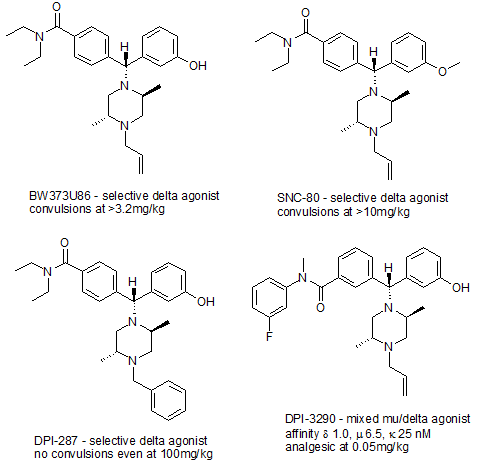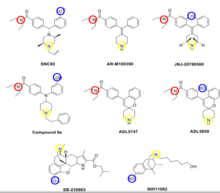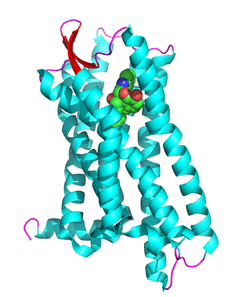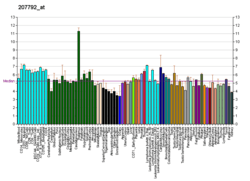δ-opioid receptor
The δ-opioid receptor, also known as delta opioid receptor or simply delta receptor, abbreviated DOR, is an inhibitory 7-transmembrane G-protein coupled receptor coupled to the G protein Gi/G0 and has enkephalins as its endogenous ligands.[5] The regions of the brain where the δ-opioid receptor is largely expressed vary from species model to species model. In humans, the δ-opioid receptor is most heavily expressed in the basal ganglia and neocortical regions of the brain.[6]
Function
The endogenous system of opioid receptors is well known for its analgesic potential; however, the exact role of δ-opioid receptor activation in pain modulation is largely up for debate. This also depends on the model at hand since receptor activity is known to change from species to species. Activation of delta receptors produces analgesia, perhaps as significant potentiators of μ-opioid receptor agonists. However, it seems like delta agonism provides heavy potentiation to any mu agonism. Therefore, even selective mu agonists can cause analgesia under the right conditions, whereas under others can cause none whatsoever.[7][8] It is also suggested however that the pain modulated by the μ-opioid receptor and that modulated by the δ-opioid receptor are distinct types, with the assertion that DOR modulates the nociception of chronic pain, while MOR modulates acute pain.[9]
Evidence for whether delta agonists produce respiratory depression is mixed; high doses of the delta agonist peptide DPDPE produced respiratory depression in sheep,[10] but in tests on mice the non-peptide delta agonist SNC-80 produced respiratory depression only at the very high dose of 40 mg/kg.[11] In contrast both the peptide delta agonist Deltorphin II and the non-peptide delta agonist (+)-BW373U86 actually stimulated respiratory function and blocked the respiratory depressant effect of the potent μ-opioid agonist alfentanil, without affecting pain relief.[12] It thus seems likely that while δ-opioid agonists can produce respiratory depression at very high doses, at lower doses they have the opposite effect, a fact that may make mixed mu/delta agonists such as DPI-3290 potentially very useful drugs that might be much safer than the μ agonists currently used for pain relief. Many delta agonists may also cause seizures at high doses, although not all delta agonists produce this effect.[13]
Of additional interest is the potential for delta agonists to be developed for use as a novel class of antidepressant drugs, following robust evidence of both antidepressant effects[14] and also upregulation of BDNF production in the brain in animal models of depression.[15] These antidepressant effects have been linked to endogenous opioid peptides acting at δ- and μ-opioid receptors,[16] and so can also be produced by enkephalinase inhibitors such as RB-101.[17] ] However, in human models the data for antidepressant effects remains inconclusive. In the 2008 Phase 2 clinical trial by Astra Zeneca, NCT00759395, 15 patients were treated with the selective delta agonist AZD 2327. The results showed no significant effect on mood suggesting that δ-opioid receptor modulation might not participate in the regulation of mood in humans. However, doses were administered at low doses and the pharmacological data also remains inconclusive.[18][19] Further trials are required.
Another interesting aspect of δ-opioid receptor function is the suggestion of μ/δ-opioid receptor interactions. At the extremes of this suggestion lies the possibility of a μ/δ opioid receptor oligomer. The evidence for this stems from the different binding profiles of typical mu and delta agonists such as morphine and DAMGO respectively, in cells that coexpress both receptors compared to those in cells that express them individually. In addition, work by Fan and coworkers shows the restoration of the binding profiles when distal carboxyl termini are truncated at either receptor, suggesting that the termini play a role in the oligomerization.[20] While this is exciting, rebuttal by the Javitch and coworkers suggest the idea of oligomerization may be overplayed. Relying on RET, Javitch and coworkers showed that RET signals were more characteristic of random proximity between receptors, rather than an actual bond formation between receptors, suggesting that discrepancies in binding profiles may be the result of downstream interactions, rather than novel effects due to oligomerization.[21] Nevertheless, coexpression of receptors remains unique and potentially useful in the treatment of mood disorders and pain.
Recent work indicates that exogenous ligands that activate the delta receptors mimic the phenomenon known as ischemic preconditioning.[22] Experimentally, if short periods of transient ischemia are induced the downstream tissues are robustly protected if longer-duration interruption of the blood supply is then affected. Opiates and opioids with DOR activity mimic this effect. In the rat model, introduction of DOR ligands results in significant cardioprotection.[23]
Ligands
Until comparatively recently, there were few pharmacological tools for the study of δ receptors. As a consequence, our understanding of their function is much more limited than those of the other opioid receptors for which selective ligands have long been available.
However, there are now several selective δ-opioid receptor agonists available, including peptides such as DPDPE and deltorphin II, and non-peptide drugs such as SNC-80,[24] the more potent (+)-BW373U86,[25] a newer drug DPI-287, which does not produce the problems with convulsions seen with the earlier agents,[26] and the mixed μ/δ agonist DPI-3290, which is a much more potent analgesic than the more highly selective δ agonists.[27] Selective antagonists for the δ receptor are also available, with the best known being the opiate derivative naltrindole.[28]

Agonists

- Peptides
- Non-peptides
- 7-Spiroindanyloxymorphone
- N-Phenethyl-14-ethoxymetopon
- ADL-5859[29]
- BU-48
- SNC-80
- BW373U86
- DPI-221
- DPI-287
- DPI-3290
- TAN-67
- RWJ-394674
- Desmethylclozapine
- Norbuprenorphine (peripherally restricted)
- Cannabidiol (allosteric modulator, non-selective)[30]
- Tetrahydrocannabinol (allosteric modulator, non-selective)[30]
- Xorphanol
Mitragyna speciosa (kratom) indole derivatives:
Antagonists
Interactions
δ-opioid receptors have been shown to interact with β2 adrenergic receptors,[31] arrestin β1[32] and GPRASP1.[33]
See also
- κ-opioid receptor
- μ-opioid receptor
References
- GRCh38: Ensembl release 89: ENSG00000116329 - Ensembl, May 2017
- GRCm38: Ensembl release 89: ENSMUSG00000050511 - Ensembl, May 2017
- "Human PubMed Reference:". National Center for Biotechnology Information, U.S. National Library of Medicine.
- "Mouse PubMed Reference:". National Center for Biotechnology Information, U.S. National Library of Medicine.
- Quock RM, Burkey TH, Varga E, Hosohata Y, Hosohata K, Cowell SM, Slate CA, Ehlert FJ, Roeske WR, Yamamura HI (Sep 1999). "The delta-opioid receptor: molecular pharmacology, signal transduction, and the determination of drug efficacy". Pharmacological Reviews. 51 (3): 503–32. PMID 10471416.
- Peppin, J.F.; Raffa, R.B. (2015). "Delta Opioid Agonists: A Concise Update on Potential Therapeutic Applications". J. Clin. Pharm. Ther. (40): 155–166.
- Varga EV, Navratilova E, Stropova D, Jambrosic J, Roeske WR, Yamamura HI (Dec 2004). "Agonist-specific regulation of the delta-opioid receptor". Life Sciences. 76 (6): 599–612. doi:10.1016/j.lfs.2004.07.020. PMID 15567186.
- Alvimopan
- Berrocoso, E.; Sánchez-Blázquez, P. (2009). "Opiates as Antidepressants". Curr. Pharm. Des. 15 (14): 1612–1622. doi:10.2174/138161209788168100. hdl:10261/62156.
- Clapp JF, Kett A, Olariu N, Omoniyi AT, Wu D, Kim H, Szeto HH (Feb 1998). "Cardiovascular and metabolic responses to two receptor-selective opioid agonists in pregnant sheep". American Journal of Obstetrics and Gynecology. 178 (2): 397–401. doi:10.1016/S0002-9378(98)80032-X. PMID 9500506.
- Gallantine EL, Meert TF (Jul 2005). "A comparison of the antinociceptive and adverse effects of the mu-opioid agonist morphine and the delta-opioid agonist SNC80". Basic & Clinical Pharmacology & Toxicology. 97 (1): 39–51. doi:10.1111/j.1742-7843.2005.pto_07.x. PMID 15943758.
- Su YF, McNutt RW, Chang KJ (Dec 1998). "Delta-opioid ligands reverse alfentanil-induced respiratory depression but not antinociception". The Journal of Pharmacology and Experimental Therapeutics. 287 (3): 815–23. PMID 9864259.
- Jutkiewicz EM, Baladi MG, Folk JE, Rice KC, Woods JH (Jun 2006). "The convulsive and electroencephalographic changes produced by nonpeptidic delta-opioid agonists in rats: comparison with pentylenetetrazol". The Journal of Pharmacology and Experimental Therapeutics. 317 (3): 1337–48. doi:10.1124/jpet.105.095810. PMID 16537798.
- Broom DC, Jutkiewicz EM, Rice KC, Traynor JR, Woods JH (Sep 2002). "Behavioral effects of delta-opioid receptor agonists: potential antidepressants?". Japanese Journal of Pharmacology. 90 (1): 1–6. doi:10.1254/jjp.90.1. PMID 12396021.
- Torregrossa MM, Jutkiewicz EM, Mosberg HI, Balboni G, Watson SJ, Woods JH (Jan 2006). "Peptidic delta opioid receptor agonists produce antidepressant-like effects in the forced swim test and regulate BDNF mRNA expression in rats". Brain Research. 1069 (1): 172–81. doi:10.1016/j.brainres.2005.11.005. PMC 1780167. PMID 16364263.
- Zhang H, Torregrossa MM, Jutkiewicz EM, Shi YG, Rice KC, Woods JH, Watson SJ, Ko MC (Feb 2006). "Endogenous opioids upregulate brain-derived neurotrophic factor mRNA through delta- and micro-opioid receptors independent of antidepressant-like effects". The European Journal of Neuroscience. 23 (4): 984–94. doi:10.1111/j.1460-9568.2006.04621.x. PMC 1462954. PMID 16519663.
- Jutkiewicz EM, Torregrossa MM, Sobczyk-Kojiro K, Mosberg HI, Folk JE, Rice KC, Watson SJ, Woods JH (Feb 2006). "Behavioral and neurobiological effects of the enkephalinase inhibitor RB101 relative to its antidepressant effects". European Journal of Pharmacology. 531 (1–3): 151–9. doi:10.1016/j.ejphar.2005.12.002. PMC 1828120. PMID 16442521.
- Hudzik TJ, Maciag C, Smith MA, Caccese R, Pietras MR, Bui KH, Coupal M, Adam L, Payza K, Griffin A, Smagin G, Song D, Swedberg MD, Brown W (Jul 2011). "Preclinical pharmacology of AZD2327: a highly selective agonist of the δ-opioid receptor". The Journal of Pharmacology and Experimental Therapeutics. 338 (1): 195–204. doi:10.1124/jpet.111.179432. PMID 21444630.
- "Study of Antidepressant Efficacy of a Selective, High Affinity Enkephalinergic Agonist in Anxious Major Depressive Disorder (AMDD) - Full Text View - ClinicalTrials.gov". clinicaltrials.gov. Retrieved 2015-12-11.
- Fan T, Varghese G, Nguyen T, Tse R, O'Dowd BF, George SR (Nov 2005). "A role for the distal carboxyl tails in generating the novel pharmacology and G protein activation profile of mu and delta opioid receptor hetero-oligomers" (PDF). The Journal of Biological Chemistry. 280 (46): 38478–88. doi:10.1074/jbc.M505644200. PMID 16159882.
- Lambert, Nevin A; Javitch, Jonathan A (2014). "Rebuttal from Nevin A. Lambert and Jonathan A. Javitch". The Journal of Physiology. 592 (12): 2449. doi:10.1113/jphysiol.2014.274241. PMC 4080929. PMID 24931947.
- Zhang J, Qian H, Zhao P, Hong SS, Xia Y (Apr 2006). "Rapid hypoxia preconditioning protects cortical neurons from glutamate toxicity through delta-opioid receptor". Stroke: A Journal of Cerebral Circulation. 37 (4): 1094–9. doi:10.1161/01.STR.0000206444.29930.18. PMID 16514101.
- Guo L, Zhang L, Zhang DC (Oct 2005). "[Mechanisms of delta-opioids cardioprotective effects in ischemia and its potential clinical applications]". Sheng Li Ke Xue Jin Zhan [Progress in Physiology] (in Chinese). 36 (4): 333–6. PMID 16408774.
- Calderon SN, Rothman RB, Porreca F, Flippen-Anderson JL, McNutt RW, Xu H, Smith LE, Bilsky EJ, Davis P, Rice KC (Jul 1994). "Probes for narcotic receptor mediated phenomena. 19. Synthesis of (+)-4-[(alpha R)-alpha-((2S,5R)-4-allyl-2,5-dimethyl-1-piperazinyl)-3- methoxybenzyl]-N,N-diethylbenzamide (SNC 80): a highly selective, nonpeptide delta opioid receptor agonist". Journal of Medicinal Chemistry. 37 (14): 2125–8. doi:10.1021/jm00040a002. PMID 8035418.
- Calderon SN, Rice KC, Rothman RB, Porreca F, Flippen-Anderson JL, Kayakiri H, Xu H, Becketts K, Smith LE, Bilsky EJ, Davis P, Horvath R (Feb 1997). "Probes for narcotic receptor mediated phenomena. 23. Synthesis, opioid receptor binding, and bioassay of the highly selective delta agonist (+)-4-[(alpha R)-alpha-((2S,5R)-4-Allyl-2,5-dimethyl-1-piperazinyl)-3-methoxybenzyl]- N,N-diethylbenzamide (SNC 80) and related novel nonpeptide delta opioid receptor ligands". Journal of Medicinal Chemistry. 40 (5): 695–704. doi:10.1021/jm960319n. PMID 9057856.
- Jutkiewicz EM (Jun 2006). "The antidepressant -like effects of delta-opioid receptor agonists". Molecular Interventions. 6 (3): 162–9. doi:10.1124/mi.6.3.7. PMID 16809477.
- Ananthan S (2006). "Opioid ligands with mixed mu/delta opioid receptor interactions: an emerging approach to novel analgesics". The AAPS Journal. 8 (1): E118-25. doi:10.1208/aapsj080114. PMC 2751430. PMID 16584118.
- Portoghese PS, Sultana M, Takemori AE (Jan 1988). "Naltrindole, a highly selective and potent non-peptide delta opioid receptor antagonist". European Journal of Pharmacology. 146 (1): 185–6. doi:10.1016/0014-2999(88)90502-X. PMID 2832195.
- Le Bourdonnec B, Windh RT, Ajello CW, Leister LK, Gu M, Chu GH, Tuthill PA, Barker WM, Koblish M, Wiant DD, Graczyk TM, Belanger S, Cassel JA, Feschenko MS, Brogdon BL, Smith SA, Christ DD, Derelanko MJ, Kutz S, Little PJ, DeHaven RN, DeHaven-Hudkins DL, Dolle RE (Oct 2008). "Potent, orally bioavailable delta opioid receptor agonists for the treatment of pain: discovery of N,N-diethyl-4-(5-hydroxyspiro[chromene-2,4'-piperidine]-4-yl)benzamide (ADL5859)". Journal of Medicinal Chemistry. 51 (19): 5893–6. doi:10.1021/jm8008986. PMID 18788723.
- Kathmann M, Flau K, Redmer A, Tränkle C, Schlicker E (Feb 2006). "Cannabidiol is an allosteric modulator at mu- and delta-opioid receptors". Naunyn-Schmiedeberg's Archives of Pharmacology. 372 (5): 354–61. doi:10.1007/s00210-006-0033-x. PMID 16489449.
- McVey M, Ramsay D, Kellett E, Rees S, Wilson S, Pope AJ, Milligan G (Apr 2001). "Monitoring receptor oligomerization using time-resolved fluorescence resonance energy transfer and bioluminescence resonance energy transfer. The human delta -opioid receptor displays constitutive oligomerization at the cell surface, which is not regulated by receptor occupancy". The Journal of Biological Chemistry. 276 (17): 14092–9. doi:10.1074/jbc.M008902200. PMID 11278447.
- Cen B, Yu Q, Guo J, Wu Y, Ling K, Cheng Z, Ma L, Pei G (Mar 2001). "Direct binding of beta-arrestins to two distinct intracellular domains of the delta opioid receptor". Journal of Neurochemistry. 76 (6): 1887–94. doi:10.1046/j.1471-4159.2001.00204.x. PMID 11259507.
- Whistler JL, Enquist J, Marley A, Fong J, Gladher F, Tsuruda P, Murray SR, Von Zastrow M (Jul 2002). "Modulation of postendocytic sorting of G protein-coupled receptors". Science. 297 (5581): 615–20. doi:10.1126/science.1073308. PMID 12142540.
Further reading
- Narita M, Funada M, Suzuki T (Jan 2001). "Regulations of opioid dependence by opioid receptor types". Pharmacology & Therapeutics. 89 (1): 1–15. doi:10.1016/S0163-7258(00)00099-1. PMID 11316510.
- Evans CJ, Keith DE, Morrison H, Magendzo K, Edwards RH (Dec 1992). "Cloning of a delta opioid receptor by functional expression". Science. 258 (5090): 1952–5. doi:10.1126/science.1335167. PMID 1335167.
- Offermanns S, Schultz G, Rosenthal W (Feb 1991). "Evidence for opioid receptor-mediated activation of the G-proteins, Go and Gi2, in membranes of neuroblastoma x glioma (NG108-15) hybrid cells". The Journal of Biological Chemistry. 266 (6): 3365–8. PMID 1671672.
- Simonin F, Befort K, Gavériaux-Ruff C, Matthes H, Nappey V, Lannes B, Micheletti G, Kieffer B (Dec 1994). "The human delta-opioid receptor: genomic organization, cDNA cloning, functional expression, and distribution in human brain". Molecular Pharmacology. 46 (6): 1015–21. PMID 7808419.
- Befort K, Mattéi MG, Roeckel N, Kieffer B (Mar 1994). "Chromosomal localization of the delta opioid receptor gene to human 1p34.3-p36.1 and mouse 4D bands by in situ hybridization". Genomics. 20 (1): 143–5. doi:10.1006/geno.1994.1146. PMID 8020949.
- Knapp RJ, Malatynska E, Fang L, Li X, Babin E, Nguyen M, Santoro G, Varga EV, Hruby VJ, Roeske WR (1994). "Identification of a human delta opioid receptor: cloning and expression". Life Sciences. 54 (25): PL463-9. doi:10.1016/0024-3205(94)90138-4. PMID 8201839.
- Georgoussi Z, Carr C, Milligan G (Jul 1993). "Direct measurements of in situ interactions of rat brain opioid receptors with the guanine nucleotide-binding protein Go". Molecular Pharmacology. 44 (1): 62–9. PMID 8393523.
- Bzdega T, Chin H, Kim H, Jung HH, Kozak CA, Klee WA (Oct 1993). "Regional expression and chromosomal localization of the delta opiate receptor gene". Proceedings of the National Academy of Sciences of the United States of America. 90 (20): 9305–9. doi:10.1073/pnas.90.20.9305. PMC 47556. PMID 8415697.
- Ho MK, Wong YH (Jun 1997). "Functional role of amino-terminal serine16 and serine27 of G alphaZ in receptor and effector coupling". Journal of Neurochemistry. 68 (6): 2514–22. doi:10.1046/j.1471-4159.1997.68062514.x. PMID 9166747.
- Hedin KE, Bell MP, Kalli KR, Huntoon CJ, Sharp BM, McKean DJ (Dec 1997). "Delta-opioid receptors expressed by Jurkat T cells enhance IL-2 secretion by increasing AP-1 complexes and activity of the NF-AT/AP-1-binding promoter element". Journal of Immunology. 159 (11): 5431–40. PMID 9548483.
- Jordan BA, Devi LA (Jun 1999). "G-protein-coupled receptor heterodimerization modulates receptor function". Nature. 399 (6737): 697–700. doi:10.1038/21441. PMC 3125690. PMID 10385123.
- Petaja-Repo UE, Hogue M, Laperriere A, Walker P, Bouvier M (May 2000). "Export from the endoplasmic reticulum represents the limiting step in the maturation and cell surface expression of the human delta opioid receptor". The Journal of Biological Chemistry. 275 (18): 13727–36. doi:10.1074/jbc.275.18.13727. PMID 10788493.
- Gelernter J, Kranzler HR (Jul 2000). "Variant detection at the delta opioid receptor (OPRD1) locus and population genetics of a novel variant affecting protein sequence". Human Genetics. 107 (1): 86–8. doi:10.1007/s004390050016. PMID 10982041.
- Guo J, Wu Y, Zhang W, Zhao J, Devi LA, Pei G, Ma L (Nov 2000). "Identification of G protein-coupled receptor kinase 2 phosphorylation sites responsible for agonist-stimulated delta-opioid receptor phosphorylation". Molecular Pharmacology. 58 (5): 1050–6. doi:10.1124/mol.58.5.1050. PMID 11040053.
- Gomes I, Jordan BA, Gupta A, Trapaidze N, Nagy V, Devi LA (Nov 2000). "Heterodimerization of mu and delta opioid receptors: A role in opiate synergy". The Journal of Neuroscience. 20 (22): RC110. doi:10.1523/JNEUROSCI.20-22-j0007.2000. PMC 3125672. PMID 11069979.
- Xu W, Chen C, Huang P, Li J, de Riel JK, Javitch JA, Liu-Chen LY (Nov 2000). "The conserved cysteine 7.38 residue is differentially accessible in the binding-site crevices of the mu, delta, and kappa opioid receptors". Biochemistry. 39 (45): 13904–15. doi:10.1021/bi001099p. PMID 11076532.
- Hartley JL, Temple GF, Brasch MA (Nov 2000). "DNA cloning using in vitro site-specific recombination". Genome Research. 10 (11): 1788–95. doi:10.1101/gr.143000. PMC 310948. PMID 11076863.
- Saeed RW, Stefano GB, Murga JD, Short TW, Qi F, Bilfinger TV, Magazine HI (Dec 2000). "Expression of functional delta opioid receptors in vascular smooth muscle". International Journal of Molecular Medicine. 6 (6): 673–7. doi:10.3892/ijmm.6.6.673. PMID 11078827.
- Xiang B, Yu GH, Guo J, Chen L, Hu W, Pei G, Ma L (Feb 2001). "Heterologous activation of protein kinase C stimulates phosphorylation of delta-opioid receptor at serine 344, resulting in beta-arrestin- and clathrin-mediated receptor internalization". The Journal of Biological Chemistry. 276 (7): 4709–16. doi:10.1074/jbc.M006187200. PMID 11085981.
- Yeo A, Samways DS, Fowler CE, Gunn-Moore F, Henderson G (Mar 2001). "Coincident signalling between the Gi/Go-coupled delta-opioid receptor and the Gq-coupled m3 muscarinic receptor at the level of intracellular free calcium in SH-SY5Y cells". Journal of Neurochemistry. 76 (6): 1688–700. doi:10.1046/j.1471-4159.2001.00185.x. PMID 11259487.
External links
- "Opioid Receptors: δ". IUPHAR Database of Receptors and Ion Channels. International Union of Basic and Clinical Pharmacology.
- delta+Opioid+Receptor at the US National Library of Medicine Medical Subject Headings (MeSH)





